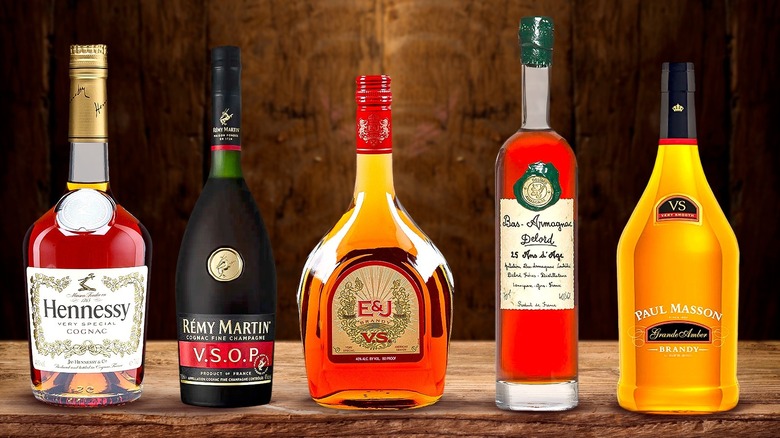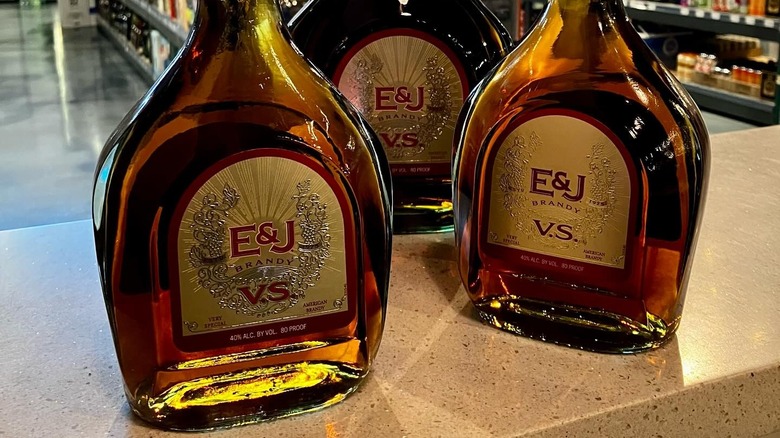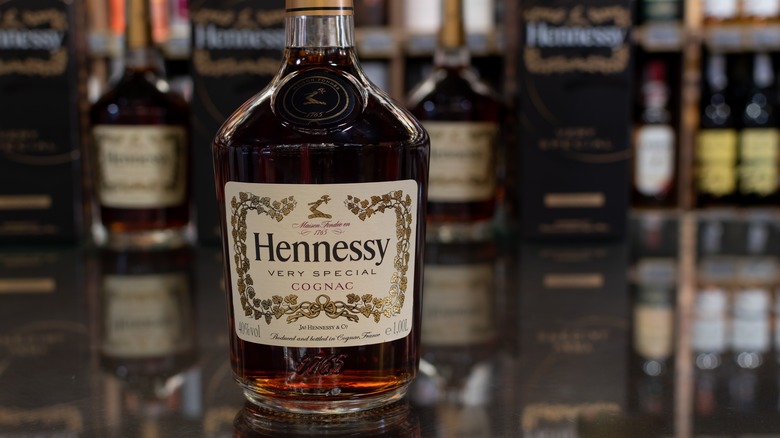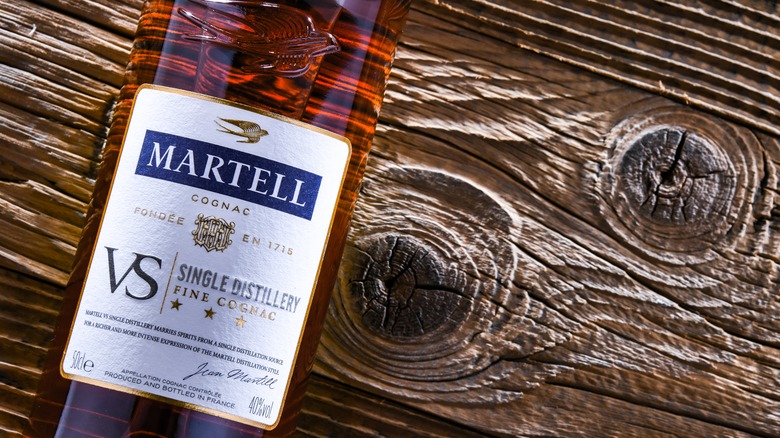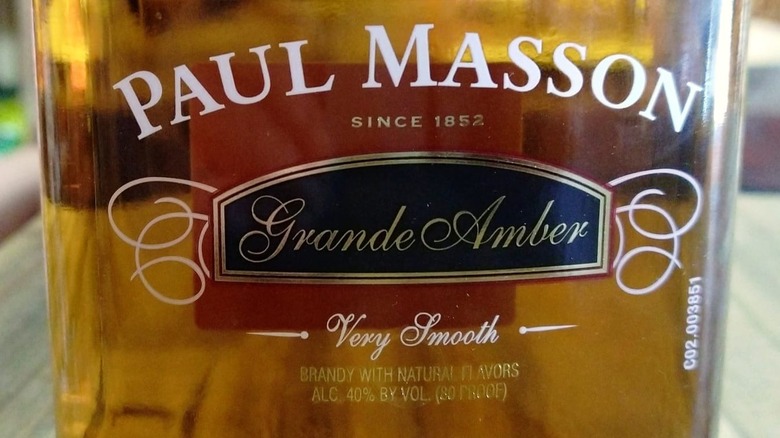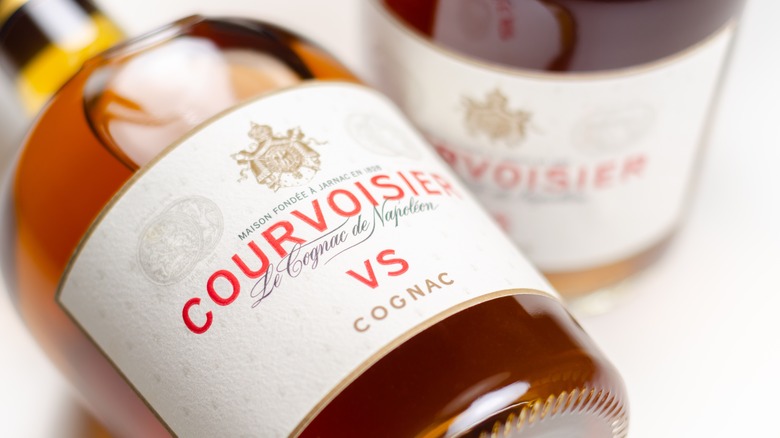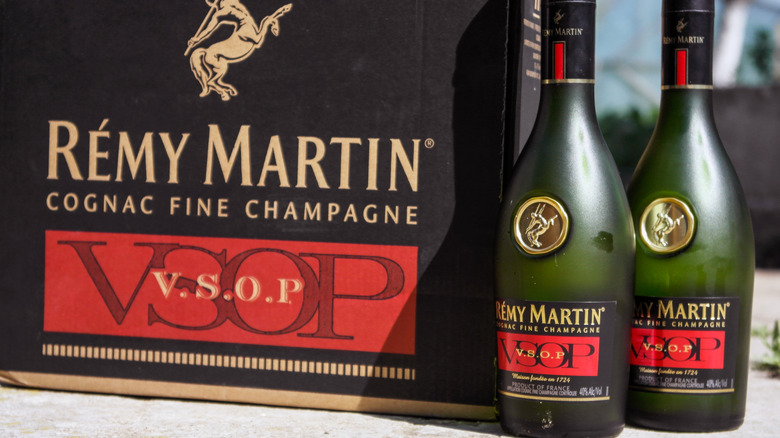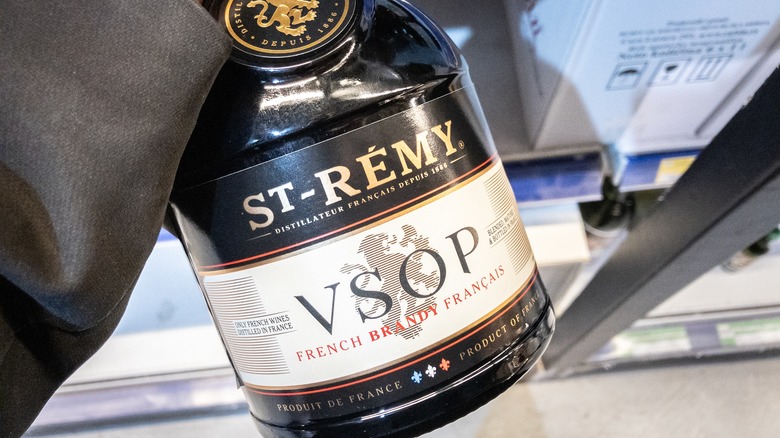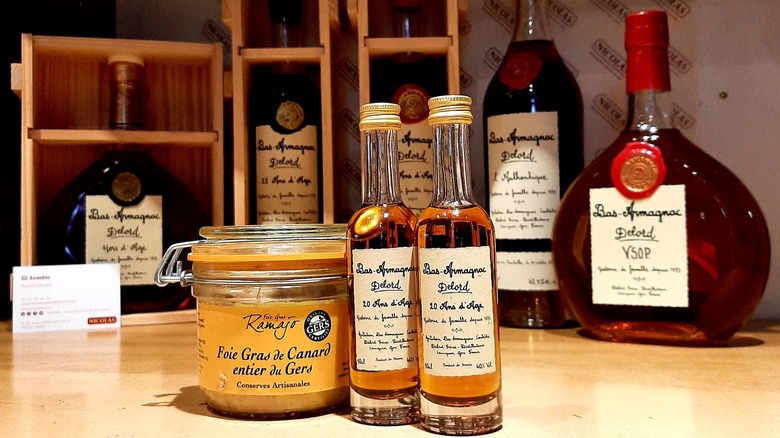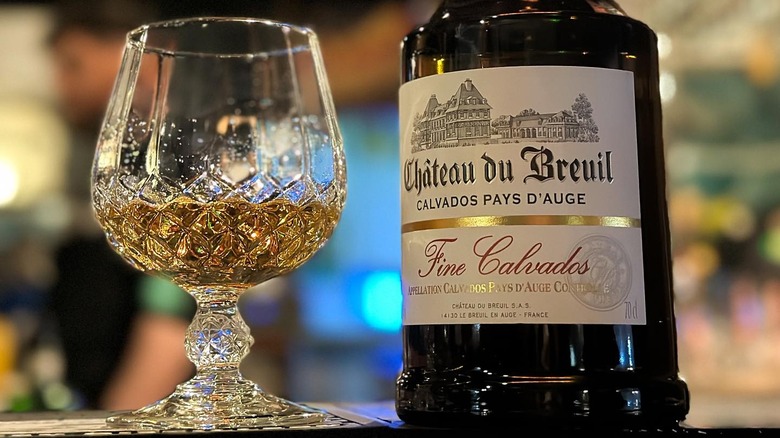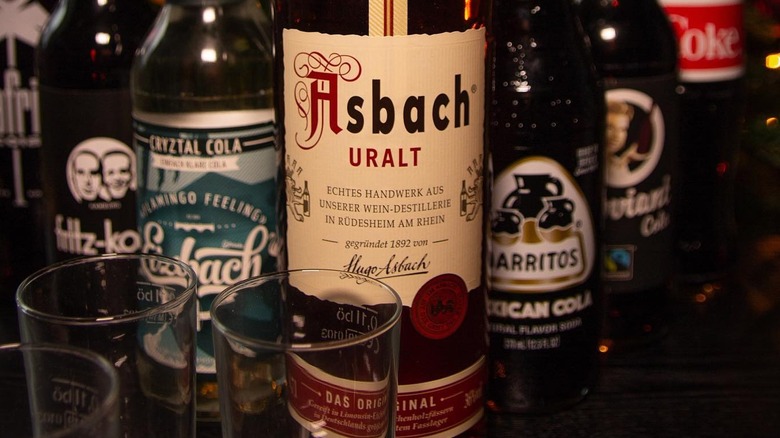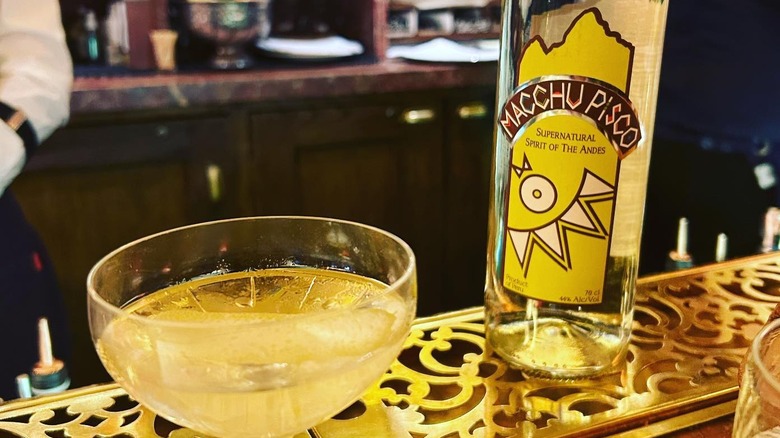11 Brandies A Bartender Recommends For A Beginner's Palate
Out of the myriad liquors that it's possible to become familiar with, in some ways, brandy is one of the trickiest. This has nothing to do with its flavor — if anything, it's one of the more approachable spirits from a taste perspective. Rather, it's due to the fact that the term "brandy" encompasses a wide range of styles, so it can be harder to find the right entry point as a newcomer.
The simplest description of brandy is that it's distilled wine. However, wine is also a broad term, and although many brandies are made with grapes, it technically covers any alcoholic beverage made by fermenting fruit. Additionally, while a brandy will typically showcase the flavors of the fruit used to make it, factors such as how the spirit is aged will also have a huge impact on the final product. This is why, despite a lengthy career as an international bartender, it took me a longer time to become acquainted with the world of brandy than it did with whiskey or rum.
Below, I've laid out a selection of brandies that I've found are excellent choices if you're looking to delve into brandy and aren't quite sure where to start. These are approachable bottles that demonstrate flavors that are typical of certain styles and are versatile enough to be enjoyed neat or mixed with other ingredients.
E&J VS
Although France is the country that most people associate with brandy — I'll explain why a little later — there are some homegrown brands that are well worth trying. E&J is an excellent example of an American brandy that's easy to source, extremely versatile, and affordable enough that you won't feel you've wasted money if it turns out brandy just isn't your thing.
E&J has a few different styles of brandy in its range, but the E&J VS is probably the best place to start. The term "VS" is one you'll come across frequently on brandy labels. It stands for "Very Special," and while it sounds a bit nondescript, it's actually an indication of the age of the brandy. Bottles that bear these initials must use eau-de-vie that's been matured in oak barrels for at least two years. Eau-de-vie — from the French, meaning "water of life" — is the name given to the clear, unaged fruit distillate used to make brandy.
E&J VS is sweet, with prominent berry and grape notes and touches of tropical fruit. There are some honey, butterscotch, and wood spice characteristics from the aging, but the brandy's youth means it's a little rough around the edges. Quality brandy is best enjoyed at room temperature in a tulip-shaped snifter glass, but I suggest mixing E&J VS with club soda or fresh apple juice to temper the heat, allowing you to better appreciate the spirit's flavors.
Hennessy VS Cognac
Before we continue, it's important to define the difference between brandy and Cognac. The simplest comparison to make is that of sparkling wine versus champagne. While brandy is a general term, Cognac is a legally recognized designation. The full definition of what makes a Cognac is lengthy and complex, but the most important factors are that it must come from a specific region of France, can only be made from a select few varieties of white grape, and has to be double-distilled.
There are four world-renowned Cognac houses responsible for roughly 85 percent of all Cognac sold around the world, and Hennessy is likely the most famous. With a legacy dating back to 1765, it's unsurprising that the Hennessy range is vast and includes bottles that have fetched hundreds of thousands of dollars at auction. However, for our purposes, we're going to stick with the entry-level VS expression.
While somewhat uncomplex, Hennessy VS has a pretty typical Cognac profile, which brings to mind lots of apple pie qualities. The nose is a little leathery and heavy with apple and baking spices, flavors that are just as present on the palate. The finish lets the cinnamon, nutmeg, and clove notes linger, but there's admittedly some noticeable alcohol heat that betrays the spirit's youth. Fortunately, the brandy's relative lack of complexity means there are plenty of great mixing options for Hennessy VS that make for a mellower drinking experience.
Martell VS Cognac
Martell isn't only one of France's "big four" Cognac houses; it's also the oldest, dating all the way back to 1715. Like Hennessy, it offers a massive selection of brandies, including rare bottles that cost more than most of us would spend on a car. Fortunately, there are still some excellent entry-level expressions, like the Martell VS Cognac.
Although all Cognacs adhere to strict production criteria, Martell is a perfect example of how this doesn't get in the way of flavor diversity. Where Hennessy VS has a bold, full-bodied profile, Martell VS is smoother and showcases a wider range of fruit. The Martell has a slightly floral, citrusy character with hints of stone fruit and vanilla, as a result of the terroir from which they source their grapes. There's also less of that spicy apple pie profile and less oak influence from the barrel.
The youth of Martell VS Cognac is also less evident, meaning it's a much smoother spirit. Although it can certainly be mixed or used in a cocktail, it's a great tipple for a brandy novice to try neat or with a few ice cubes. The elegance of Martell's brandy makes it a lot easier to appreciate the nuanced fruit notes, and it's definitely worth trying if you've tasted richer brandies that felt too heavy or overpowering.
Paul Masson Brandy Grande Amber VS
Although the Paul Masson brand isn't as esteemed as other brandy producers, there's something to be said about its influence on American wine and brand-making. The eponymous Masson, a Frenchman, was one of the earliest pioneers of grape cultivation in 19th-century California.
In the early 20th century, Paul Masson was known for its sparkling wines, and while the company still produces some budget wine, its current focus is on brandy. However, its range isn't huge and includes more flavored brandies than regular expressions. It's also worth noting that despite using the initials VS, the label indicates this stands for "Very Smooth." As an American brandy, Paul Masson isn't beholden to the same regulations as French Cognac. However, Paul Masson Grande Amber VS is aged three years, which is still a whole year longer than the French rules dictate.
Although the Grande Amber VS is a lower quality brandy than the Hennessy and Martell, it offers a pleasant middle-ground between their flavor profiles. The additional aging and use of American oak casks give the brandy a nice amount of oak and caramel character and help smooth out what would otherwise be a rough, spirit-forward mouthfeel. It has a floral quality that complements the tropical fruit notes, with hints of pepper and milk chocolate. Ultimately, it's a well-balanced and versatile spirit that's great for brandy novices, plus it boasts a remarkably low price.
Courvoisier VS
Although Courvoisier is the youngest of the big four Cognac houses, it's managed to earn an astounding global reputation. This is partly due to the brand's strong relationship with Napoleon Bonaparte and his son, Napoleon III, who made Courvoisier the "Official Supplier to the Imperial Court." In fact, Courvoisier has even earned the moniker "Napoleon's Cognac."
What's interesting about Courvoisier is that it doesn't own a single vineyard or distill its own Cognac, although it does dictate how the brandy is made. It also blends and ages the eau-de-vie, so the company still has full control over what goes in the final bottle. Courvoisier VS is a grape-forward brandy that showcases a wide range of typical brandy flavors. It's relatively youthful but still boasts some darker tasting notes, such as dried fruit and honey. There are some light floral notes and touches of grass, milk chocolate, and citrus, and its sweetness isn't overpowering.
This is a great cognac for learning to pick out some of brandy's most common flavors, but if there's one drawback, it's that there are possibly too many things going on. The palate can come across as muddled due to multiple tasting notes that sometimes conflict with one another. That said, it's good value for money, and it's well-suited for mixing or enjoying neat.
Rémy Martin VSOP
Now, we arrive at the last of the "big four" Cognac houses. The second-oldest of the group, Rémy Martin was founded in 1724 and has been producing world-class brandy for over 300 years. It's worth addressing that the labels on bottles of Rémy Martin bear the statement "Cognac Fine Champagne," which can be a little confusing. This isn't an indication that Rémy Martin is a sparkling brandy. There's some overlap between what's considered the Cognac region and the Champagne region in France, and Rémy Martin uses grapes from this particular area.
It's also important to note the "VSOP" designation, which can stand for "Very Special Old Pale" or "Very Superior Old Pale." VSOP Cognacs must be made using eau-de-vie that's been aged for a minimum of four years, which is why Rémy Martin VSOP has more barrel character and tastes notably smoother.
The fruit notes are relatively light, with stone fruit elements like peach and apricot. The additional aging is responsible for strong vanilla and oak flavors and provides no shortage of honey, caramel, and a tannic quality that balances out the spirit's sweeter aspects. Although Rémy Martin VSOP is a great sipping Cognac, it's also a worthy component for cocktails, whether you're making a classic sidecar or an indulgent brandy Alexander. This Cognac is robust enough to form a solid backbone in mixed drinks yet balanced in a way that elevates the other ingredients without overwhelming them.
St-Rémy VSOP
Founded in 1886, St-Rémy shares a parent company with Rémy Martin, but it's important to note that the two are otherwise unrelated. One of the key distinctions is that St-Rémy is considered a French brandy, not a Cognac. It's produced outside of the Cognac region and uses a combination of both red and white grapes.
However, just because St-Rémy isn't technically a Cognac, that doesn't mean it isn't a solid choice of brandy. Admittedly, the higher end of the St-Rémy range can't compete with the opulent offerings of other producers, but we're not here to talk about the best brandies for wealthy connoisseurs. St-Rémy VSOP is an incredibly delicate brandy with a light body, but it still manages to highlight plenty of unique tasting notes. Green apple and pear sit neatly alongside the inherent grape flavor, but the barrel-aging offers deeper, complimentary fruit flavors. Jammy fig, rich dates, and juicy raisins give the brandy a darker side, and there's a good helping of leather, baking spice, vanilla, oak, and even a touch of tobacco.
Despite the wealth of flavors, St-Rémy VSOP isn't overly complex, and although its elegance makes it a good option for sipping neat, it works extremely well in cocktails and can even be used as a fruit substitute for whiskey. Throw in the fact that St-Rémy VSOP has an extremely low price; it's a great "well brandy" for a bartender to have on hand.
Delord Bas Armagnac 20 Year Old
When it comes to French brandy, Cognac tends to get most of the attention, but it has a cousin that's often overlooked by those less familiar with the spirit. Armagnac is a style of brandy that's even older than Cognac — possibly the oldest wine-based spirit in the world — and must also be produced within the region of the country from which it gets its name.
Armagnac also has to be made with specific types of white grape, but the biggest distinction from a taste perspective comes from the distillation process. Typically, Armagnac is distilled only once, compared to the double distillation that Cognac must undergo, and uses a different type of still. The result is a spirit that's bigger and bolder, with a hearty complexity that gets better with age.
Delord has been making fine Armagnac since the late 19th century, and despite many of their brandies boasting lengthy age statements, they're more affordable than you might expect. The Delord Bas Armagnac 20 Year Old has an incredible depth of character with rich notes of dried fruit, brown sugar, toffee, and caramel. There's a delicious nuttiness to the brandy that's complemented with soft baking spice, and while Armagnacs aren't usually as refined as Cognacs, the two decades of maturation result in a beautifully supple spirit. The best way to enjoy it is with decadent food — think foie gras, smoked salmon, mature cheese, dark chocolate, or even caviar.
Château du Breuil Fine Calvados Pays d'Auge
After Cognac and Armagnac, there's one other type of French brandy that's given its own distinct classification. Calvados is made in the Normandy region, but it's not made from grapes. Instead, Calvados is made by fermenting apples — sometimes pears as well — into a cider, which is then distilled twice.
It should come as no surprise that Calvados is more apple-forward than other styles of brandy, but it can still provide plenty of complexity, especially with aging. Younger expressions tend to offer more of a baked fruit profile, while more mature bottles develop woodier, spicier flavors. Pays d'Auge Calvados is a particular style that's known for being incredibly smooth. Although Château du Breuil Fine Calvados is only aged for up to three years, you'd be forgiven for thinking it's much older thanks to its notes of sweet caramel, wood spice, and sticky apple.
Château du Breuil Fine Calvados Pays d'Auge may boast a range of rich flavors, but it's still relatively light, making it a highly versatile brandy and a great option for beginners. If neat spirits aren't your thing, it's delicious when combined with a suitable mixer, like spicy ginger beer. This Calvados is also a great substitute for Cognac in cocktails that you want to put an apple pie twist on, and it's particularly effective for fortifying homemade mulled wine.
Asbach Uralt Brandy
Although French brandy gets the most attention, that doesn't mean neighboring countries don't have anything to offer. Germany is famed for its various fruit brandies — known as schnaps — and it would be a mistake to overlook what it has to offer.
One of the most famous German brandies is Asbach Uralt, which has been around since the tail end of the 19th century. However, it wasn't until the early 20th century that it began to pick up something of a cult following. British and American servicemen stationed in Germany during and after the World Wars had a particular affinity for Asbach brandy. Asbach Uralt is definitely influenced by Cognac — it's distilled twice in copper pot stills and aged in barrels made from Limousin oak, the same type used for Cognac — it has a flavor profile of its own.
Asbach Uralt is sweeter than most Cognacs and has a character that's somewhat similar to bourbon. The grape notes are fortified by darker fruit flavors and lashings of rich caramel and vanilla. Although Uralt is the youngest of Asbach's brandies, it's notably smooth, and there's still a strong presence of spicy, leathery oak that contributes to its full body. Asbach Uralt can certainly be enjoyed neat, but if you want to follow German tradition, you should drink it in a highball glass with cola or use a few splashes to liven up your coffee.
Macchu Pisco
So far, this list has stuck with European brandy styles, and for good reason. In my experience, these are generally the most approachable for beginners, but it would be remiss of me to leave out South America's iconic contribution — pisco.
Pisco is made by distilling fermented grape juice, and it's believed to date all the way back to the 16th century. Many agree the spirit was invented by Spanish conquistadors who occupied the region at this time and needed a use for the grapes that weren't suitable for wine-making. However, the precise birthplace of this brandy is still hotly debated. Both Chile and Peru lay claim to pisco, and both countries claim it as their national spirit. While there are some differences between Chilean and Peruvian and pisco, they have more in common than they do with European brandies, like Cognac. The most distinct factor is that although pisco is aged, it's for a much shorter time and only in vessels that have no impact on the spirit's flavor.
Despite the lack of oak barrel aging, Macchu Pisco is an excellent example of a smooth, high-quality pisco. It's savory, floral, and slightly herbaceous, with notes of grass and citrus that sit beautifully alongside the prominent grape base. Neat pisco isn't for everyone, but there are some iconic cocktails that make excellent use of it. The classic pisco sour is a must-try, and there's also San Francisco's legendary pisco punch for the more adventurous drinkers.
